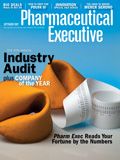Counterfeit Drugs, One Click Away
Pharmaceutical Executive
If it looks too good to be true.... The price is unbeatable, the Web site proudly displays an accreditation seal of approval, medicines are advertised as "generics" of the branded versions (implying bioequivalence with respect to safety and efficacy), and patients never have to leave their homes. Marcia Bergeron, a 57-year-old Canadian resident likely had these things in mind when she purchased antianxiety and sedative medication from an online pharmacy. The pills she received from the Web site, however, caused hair loss and vision problems, and ultimately resulted in her death. The coroner's toxicology report showed that the pills she purchased online were laced with traces of dangerous metals, including uranium, strontium, selenium, aluminum, and arsenic. Bergeron, like many others around the world, was a victim of the counterfeit-medicine business, an industry that the US-based Center for Medicine in the Public Interest (CMPI) predicts will reach $75 billion in sales globally by 2010.
If it looks too good to be true.... The price is unbeatable, the Web site proudly displays an accreditation seal of approval, medicines are advertised as "generics" of the branded versions (implying bioequivalence with respect to safety and efficacy), and patients never have to leave their homes. Marcia Bergeron, a 57-year-old Canadian resident likely had these things in mind when she purchased antianxiety and sedative medication from an online pharmacy. The pills she received from the Web site, however, caused hair loss and vision problems, and ultimately resulted in her death. The coroner's toxicology report showed that the pills she purchased online were laced with traces of dangerous metals, including uranium, strontium, selenium, aluminum, and arsenic. Bergeron, like many others around the world, was a victim of the counterfeit-medicine business, an industry that the US-based Center for Medicine in the Public Interest (CMPI) predicts will reach $75 billion in sales globally by 2010.

Mark Mutterperl
Counterfeit drugs are drugs that look like branded or generic medicines but have been deliberately and fraudulently mislabeled with respect to their source or origin. A counterfeit drug's composition will fall into one of these categories: no active ingredients, too much or too little of the active ingredients, or the wrong ingredients—as in Marcia Bergeron's case. Although distribution of counterfeit medicines in brick-and-mortar pharmacies has long plagued regulators and trademark owners, the Internet—with its electronic interface, user convenience, and seller anonymity—has greatly enhanced the international trade of counterfeit pharmaceuticals and made it more difficult to trace and prosecute counterfeiters. According to US Immigration and Customs Enforcement, the Internet has become "the primary tool for criminal organizations to advertise, communicate, and conduct sales of counterfeit pharmaceuticals" and is "the primary mechanism for consumers to find, order, and make payments for counterfeit pharmaceuticals."

Bruce Longbottom
Since counterfeiters went online, fighting counterfeiting has become more difficult. Laws that were enacted to address counterfeiting in the brick-and-mortar world (where stores and warehouses can be raided, counterfeits seized, and counterfeiters arrested) do not work well in the electronic, borderless, anonymous world of the Internet. There are several ways to mask the identity of people or companies operating a Web site. If they are located and a judgment is obtained against them in court, enforcement of that judgment in the countries where they are located may be difficult or impossible. Even if one Web site is successfully shut down, others are likely to pop up—the fight is reminiscent of the fairground game Whac-a-Mole.
Although attacking online counterfeiters is difficult (at least until better enforcement tools are provided), there are some steps that pharmaceutical companies can take. For instance, companies can use a Uniform Domain Name Dispute Resolution action to obtain a counterfeiting Web site's domain name if it contains the company's trademark. This action, if successful, will stop the counterfeiter from operating that site, but it will not stop the counterfeiter from operating another site that does not contain the company's trademark. Companies may also contact the Web site's host or the Web site registrar to take down the counterfeiter's site or disable the counterfeiter's domain name, respectively. Some hosts and registrars will cooperate, while others will require a court order.
But pharma companies should make sure they focus on internal measures as well. Some steps to consider include:
•securing the supply chain of products, including audits of wholesalers and use of track-and-trace technology
•using overt/covert technology features on products and packaging to help authenticate products
•deterring counterfeiters through targeted investigations and working with law-enforcement agencies on raids, arrests, and criminal prosecutions
•filing civil actions against select targets to obtain injunctions and impose financial penalties
•monitoring the Internet to try to disrupt online sales
•recording trademarks with customs to encourage seizures of counterfeits as they cross national borders
•establishing a means to coordinate cross-functional efforts within the company, such as a central anti-counterfeiting office.
In addition, pharmaceutical companies are encouraged to, whenever possible, participate in regional, national, and international anti-counterfeiting initiatives (such as by warning against the dangers of buying medicine online), because government and public-awareness-raising campaigns are central to the promotion of Internet-specific laws and to reducing the demand for counterfeits.
Even if pharma and the government take safety and prevention measures, the Internet will remain at the heart of stakeholder debates on counterfeiting today. One disturbing trend has been for consumers who are victims of counterfeit products (including pharmaceuticals) to sue the company whose product was counterfeited (also a victim) on various grounds, including negligence and product liability. For example, after a 2003 recall of 18 million tablets of counterfeit Lipitor (atorvastatin), Pfizer was sued for an alleged failure to monitor the distribution chain for its product. The case was dismissed since Pfizer did not participate in the counterfeit operation and had no duty to anticipate criminal tampering with its products. Amgen was sued for negligence after counterfeit Epogen (epoetin) reached patients, but ultimately settled the case in 2006. Similarly, a class action was brought against Procter & Gamble for harm that might have been caused by counterfeit hair-care products on a product-liability theory. The plaintiffs asserted that the company had a duty to warn consumers of the potential harm of counterfeits; the court dismissed the class action for failure to state a claim. Even though companies should not be held responsible for products that are not theirs, these recent cases indicate the need for pharmaceutical companies to be ready to demonstrate their commitment to protect consumers/patients from counterfeit products.
Therefore, pharmaceutical companies must continue to move beyond traditional methods of stopping counterfeiters. One important US initiative to fight pharmaceutical counterfeiting online is the draft US Safe Internet Pharmacy Act of 2007 (S. 596). That act would require each Internet pharmacy offering prescription drugs in the United States to:
•be licensed by FDA
•maintain an agent in every state where it is doing business
•post on its Web site the pharmacy's street address, telephone number, names of pharmacists, and seal
•dispense only after receipt of a valid prescription from the treating provider.
The act would also require regulations to block financial transactions from illegal online pharmacies and would grant US courts jurisdiction to order interactive service providers to remove/disable links to illegal online pharmacies. As the act is currently drafted, it is not clear who would have the responsibility or resources to enforce this remove/disable provision. Some pharmaceutical companies are seeking to amend the act in a way that would provide them a private right of action to protect their brands against online counterfeits.
The World Health Organization International Medical Product Anti-Counterfeiting Taskforce (IMPACT) acknowledges the Internet as contributing to the expansion of pharmaceutical counterfeiting. Moreover, in January 2007, the Third Global Congress on Combating Counterfeiting and Piracy recognized the need to identify solutions specific to Internet counterfeiting. In addition, the International Trademark Association is looking into the phenomenon of Internet-facilitated sales of counterfeits, and the organization is likely to produce a comprehensive analysis on the subject. It is imperative for pharmaceutical companies to take part in the debate and lobby for changes to existing law to address this real and growing problem.
Of course, all these measures may involve added resources and expanded budgets without a clear way of measuring the benefit of such an investment. Pharmaceutical executives may say, "We can't afford that." However, when considering the obvious losses in revenue and brand value—and, more importantly, the grave risk posed to the health and safety of patients such as Marcia Bergeron—the clear response is, "We can't afford not to."
Additional reporting by Chehrazade Chemcham and Jessica Parise
Mark Mutterperl is a partner in the intellectual property and technology department of Fulbright & Jaworski. He can be reached at mmutterperl@fulbright.com
Bruce Longbottom is associate general counsel, trademarks and copyrights, for Eli Lilly. He can be reached at longbottom_bruce@lilly.com

MDMA Therapy for Mental Health Conditions: Do the Benefits Outweigh the Risks?
October 25th 2024Despite a recent FDA Complete Response Letter issued to Lykos for midomafetamine capsules for the treatment of post-traumatic stress disorder, experts believe that the future is bright for psychedelic drugs that treat mental health conditions.
Securities Litigation Arising from Alzheimer's Drug Treatments
September 25th 2024The legal challenges surrounding Biogen’s Aduhelm and Cassava Sciences’ simufilam underscore the ongoing difficulties in Alzheimer's drug development, leading to securities litigation over allegedly misleading statements about trial results and commercialization efforts.